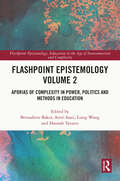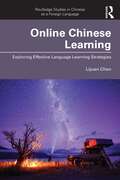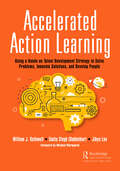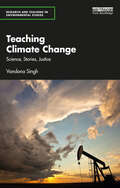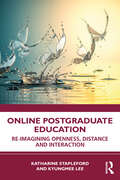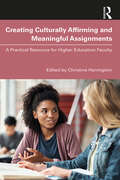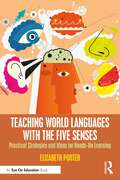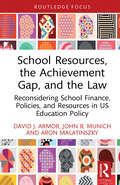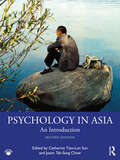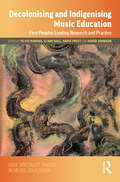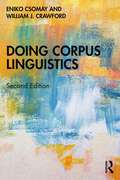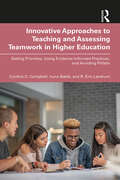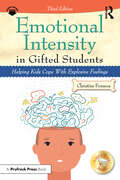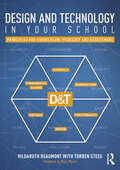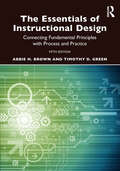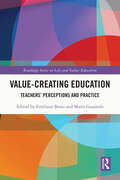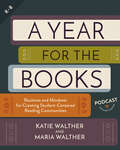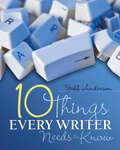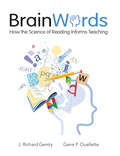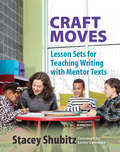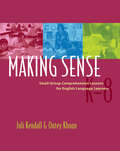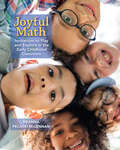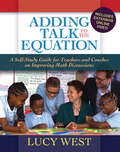- Table View
- List View
Flashpoint Epistemology Volume 2: Aporias of Complexity in Power, Politics and Methods in Education (Flashpoint Epistemology)
by Liang Wang Bernadette Baker Antti Saari Hannah TavaresThe 21st century is steeped in claims to interconnection, technological innovation, and new affective intensities amid challenges to the primacy and centrality of "the human". Flashpoint epistemology attends to the lived difficulties that arise in teaching, policymaking, curriculum, and research among continuous practices of differentiation, and for which there is no pre-existing template for judgment, resolution, or action. Flashpoint Epistemology Volume 2 brings creative sociopolitical research perspectives to flashpoints that emerge amid appeals to globalization, synoptic policy approaches, and new technologies – however defined. The chapters challenge prevailing notions of distance and difference, comparative philosophy, worlding practices, and contact zones. In the remaking of subjects, the unhoming of geopolitics, and new approaches to relationality, youth, and classrooms, complexities in preserving and questioning identity are laid bare and renovated. How technologies challenge and redefine racialization, engendering, and inter/nationalization are examined amid the reworking of oppression, success, well-being, politics, method, and power. The volume will be beneficial for researchers seeking new approaches to education’s complexities, nested discourses, and ever-moving horizons of enactment. It is also a key text for post/graduate students and teachers interested in technological impact, globality, policymaking, and new ways of conducting research in contexts of digitalization and social media.
Online Chinese Learning: Exploring Effective Language Learning Strategies (Routledge Studies in Chinese as a Foreign Language)
by Lijuan ChenOnline Chinese Learning aims to investigate the types of language learning strategies (LLSs) that online Chinese learners use across asynchronous and synchronous learning environments in different learning contexts.This book examines how the use of language learning strategies by online Chinese learners is influenced by the interactants; the characteristics of the specific learning context; and selected individual learner characteristics. This book will provide: (1) new and detailed information about students’ LLS use in online Chinese learning; (2) insights into how individual students adopt LLSs and technological tools to solve learning problems in various learning contexts; (3) an exploration of factors influencing LLS use; and (4) recommendations regarding LLS adoption, use, and training.This book will be a valuable resource for university instructors in languages, language teaching methods, and second language acquisition, as well as researchers in languages, linguistics, and language learning and teaching.
Accelerated Action Learning: Using a Hands-on Talent Development Strategy to Solve Problems, Innovate Solutions, and Develop People
by William J. Rothwell Jihye Lee Smita Singh (Dabholkar)In a knowledge-based society, people should not simply collect knowledge but should utilize and apply it to solve a problem. Action learning makes organizational members learn while solving real problems in the workplace. However, traditional action learning might not be effective for rapidly changing environments, because it is typically a process that requires substantial time. Therefore, this book provides a guideline on how to apply action learning quickly in workplaces—especially in virtual settings. Action learning allows the organization to develop people while, at the same time, getting work done. It is an alternative to classroom-based and online learning programs. In addition, it can also be an alternative to the instructional systems design (ISD) model or the successive approximation model (SAM) as a means of developing planned instruction if used for that purpose. Action learning can be an effective tool for Web 2.0 learning. Many organizations are now using self-directed teams and other team formats for work. It makes sense to revisit planned on-the-job training and learning with an emphasis on teams. Action learning is a process involving a small group with facilitators and action-learning process managers, so it is one of the best options for team-based problem-solving. This book provides real action learning cases. There are needs that have emerged in these post-pandemic times. There is a need to explain how action learning can be applied to various settings, issues, and challenges. Since COVID-19 occurred, many people must work in virtual or hybrid settings. This book gives trainers—who could be HR managers, operating managers, or learning and development professionals—guidelines that can be used in virtual settings to meet the new needs. Essentially, this book is written for team facilitators, supervisors, managers, or team members who wish to plan action-oriented, problem-based, and work-related learning experiences in real time. Because many action-learning books are written for an academic audience, it is not easy to put action learning into practice. Therefore, the goal of this book is to provide guidelines on how action learning starts, what basic principles should be considered, and what tools and techniques are needed for rapid action learning. The book is intended to be a primer on how to facilitate a planned learning project in a team or workgroup.
Teaching Climate Change: Science, Stories, Justice (Research and Teaching in Environmental Studies)
by Vandana SinghTeaching Climate Change: Science, Stories, Justice shows educators how climate change can be taught from any disciplinary perspective and in a transdisciplinary way, drawing on examples from the author's own classroom. The book sets out a radical vision for climate pedagogy, introducing an innovative framework in which the scientific essentials of climate change are scaffolded via three transdisciplinary meta-concepts: Balance/Imbalance, Critical Thresholds and Complex Interconnections. Author Vandana Singh grounds this theory in practice, drawing on examples from her own classroom to provide implementable ideas for educators, and to demonstrate how climate change can be taught from any disciplinary perspective in a transdisciplinary way. The book also explores the barriers to effective climate education at a macro level, focusing on issues such as climate misinformation/misconception, the exclusion of social and ethical concerns and a focus on technofixes. Singh uses this information to identify four key dimensions for an effective climate pedagogy, in which issues of justice are central: scientific-technological, the transdisciplinary, the epistemological and the psychosocial. This approach is broad and flexible enough to be adapted to different classrooms and contexts. Bridging the social and natural sciences, this book will be an essential resource for all climate change educators practicing in both formal and informal settings, as well as for community climate activists.
Online Postgraduate Education: Re-imagining Openness, Distance and Interaction
by Katharine Stapleford Kyungmee LeeProviding a comprehensive examination of the nature of online higher education, this book proposes effective ways in which it can be conceptualised and designed to be more accessible and authentic for adult learners.Against the backdrop of differing historical origins, which have resulted in multiple, misaligned understandings, applications and interpretations of online and distance education, this book presents an empirical research study which uses a narrative approach to explore the lived experiences of online postgraduate students. It positions two arguments on the (in-)accessibility and (in-)authenticity of online education side by side, effectively demonstrating how they can be conflict and contradict each other. Using narrative data, the authors re-examine the concepts of distance and interaction in order to present a new understanding of the concept of openness relevant to the for-profit postgraduate distance learning sector. This book illuminates the postgraduate distance education experience and presents a set of alternative theoretically informed conceptions which the authors present as three essential pillars of online postgraduate education: openness, distance, and interaction. Carefully presented and supported using real online higher education scenarios, the book will enable higher educators, practising online education in a range of pedagogical contexts, to re-imagine their practices; further, to create more accessible and authentic learning opportunities for their learners.
Creating Culturally Affirming and Meaningful Assignments: A Practical Resource for Higher Education Faculty
by Christine HarringtonCreating Culturally Affirming and Meaningful Assignments offers principles, strategies, and examples to aid in the development of inclusive college coursework in which all students feel seen and valued. This resource prepares instructors to proactively consider ways to honor and engage with students’ varied identities and lived experiences through assignments. Chapters cover the course design process, methods on getting to know your students, assignment options beyond the exam, and more. Reflection questions at the end of each chapter serve as a springboard for faculty and leadership conversations on equitable and inclusive teaching practices, while the appendix features 20 example assignments sourced from various higher education disciplines. An accessible, practical read, this guidebook is for any higher education instructor who wants to reimagine their assignments to center and celebrate students’ varied cultural backgrounds and experiences.
Teaching World Languages with the Five Senses: Practical Strategies and Ideas for Hands-On Learning
by Elizabeth PorterWith this fun, practical guide, you will have everything you need to re-envision and reinvigorate your world language classroom. Author Elizabeth Porter draws on a brain-based approach to show how language learning is a sensory experience. Students can effectively learn languages and improve retention through activities and lessons that incorporate the five senses – sight, hearing, taste, touch, and smell. Chapters include real-world, research-backed examples and classroom strategies and activities ready for use. An essential resource for world language teachers, this book introduces language learning philosophy and an out-of-the-box, effective approach that uses neuroscience combined with best practices to promote a highly engaging language learning environment.
Teaching World Languages with the Five Senses: Practical Strategies and Ideas for Hands-On Learning
by Elizabeth PorterWith this fun, practical guide, you will have everything you need to re-envision and reinvigorate your world language classroom. Author Elizabeth Porter draws on a brain-based approach to show how language learning is a sensory experience. Students can effectively learn languages and improve retention through activities and lessons that incorporate the five senses – sight, hearing, taste, touch, and smell. Chapters include real-world, research-backed examples and classroom strategies and activities ready for use. An essential resource for world language teachers, this book introduces language learning philosophy and an out-of-the-box, effective approach that uses neuroscience combined with best practices to promote a highly engaging language learning environment.
School Resources, the Achievement Gap, and the Law: Reconsidering School Finance, Policies, and Resources in US Education Policy (Routledge Research in Education Policy and Politics)
by David J. Armor John R. Munich Aron MalatinszkyThis book offers a novel and up-to-date exploration of the common belief that increasing conventional school resources will increase academic achievement and help close gaps between various advantaged and disadvantaged students. Taking the scholarship around this question, such as James S. Coleman’s 1965 report on the Equality of Educational Opportunity, as a starting point, it brings in an extensive range of contemporary data sources and statistical analysis to offer an updated, robust, and considered review of the issue. Moving beyond these empirical questions, it also explores how these empirical findings have been utilized in “education adequacy” litigation, discussing the evolving law of adequacy cases, while explaining the challenges of introducing complex data and analyses within a litigation framework. Judges typically have little experience with the complexity of modern education data and the analyses required to draw sound inferences. It will thus be of interest to scholars, researchers, and faculty with expertise in education policy, the economics and sociology of education, and public policy.
School Resources, the Achievement Gap, and the Law: Reconsidering School Finance, Policies, and Resources in US Education Policy (Routledge Research in Education Policy and Politics)
by David J. Armor John R. Munich Aron MalatinszkyThis book offers a novel and up-to-date exploration of the common belief that increasing conventional school resources will increase academic achievement and help close gaps between various advantaged and disadvantaged students. Taking the scholarship around this question, such as James S. Coleman’s 1965 report on the Equality of Educational Opportunity, as a starting point, it brings in an extensive range of contemporary data sources and statistical analysis to offer an updated, robust, and considered review of the issue. Moving beyond these empirical questions, it also explores how these empirical findings have been utilized in “education adequacy” litigation, discussing the evolving law of adequacy cases, while explaining the challenges of introducing complex data and analyses within a litigation framework. Judges typically have little experience with the complexity of modern education data and the analyses required to draw sound inferences. It will thus be of interest to scholars, researchers, and faculty and jurists with expertise or interest in education policy, the economics and sociology of education, and public policy.
Psychology in Asia: An Introduction
by Catherine Tien-Lun Sun Jason Tak-Sang ChowPsychology in Asia: An Introduction is the second edition of this introductory level textbook on psychology and human behavior written with an Asian focus.The book introduces the central tenets of psychology, using examples and content which are culturally relevant and applicable to students in Asia. It covers essential topics of psychology including: personality, human development, psychological disorders, gender and sexuality, emotion, and positive psychology. Each chapter is accompanied by information relevant to an Asian cultural context and connected to the region’s diverse heritage and history. For this second edition, the content has been substantially updated. In addition to standard topics found in texts on introductory psychology, this book includes chapters on the Tenets of Asian Psychology, Asian Philosophies, and Behavior.The text includes features to help students familiarize themselves with the key terms that are defined in the page margins. It includes learning aids such as boxes that define theoretical and technical terms, and the activities in each chapter encourage active learning and critical thinking. The authors also provide useful resources such as study questions, chapter outlines, and references to journal articles that allow further reading. Students will benefit from an increased understanding of the concepts taught through the authors' user-friendly academic writing style and colorful illustrations included throughout each chapter.Through this accessible text, undergraduate and upper undergraduate students of psychology will learn about core topics and classical studies that originate in the West but do so alongside the important contributions that Asian psychology makes to the field.
Decolonising and Indigenising Music Education: First Peoples Leading Research and Practice (ISME Series in Music Education)
by Te Oti Rakena, Clare Hall, Anita Prest and David JohnsonCentring the voices of Indigenous scholars at the intersection of music and education, this co-edited volume contributes to debates about current colonising music education research and practices, and offers alternative decolonising approaches that support music education imbued with Indigenous perspectives. This unique collection is far-ranging, with contributions from Chile, New Zealand, Australia, Canada, Malaysia, India, South Africa, Kenya, and Finland. The authors interrogate and theorise research methodologies, curricula, and practices related to the learning and teaching of music. Providing a meeting place for Indigenous voices and viewpoints from around the globe, this book highlights the imperative that Indigenisation must be Indigenous-led.The book promotes Indigenous scholars’ reconceptualisations of how music education is researched and practised, with an emphasis on the application of decolonial ways of being. The authors provocatively demonstrate the value of power-sharing and eroding the gaze of non-Indigenous populations. Pushing far beyond the concepts of Western aesthetics and world music, this vital collection of scholarship presents music in education as a social and political action, and shows how to enact Indigenising and decolonising practices in a wide range of music education contexts.
Doing Corpus Linguistics
by Eniko Csomay William J. CrawfordDoing Corpus Linguistics offers a practical step-by-step introduction to corpus linguistics, making use of widely available corpora and of a register analysis-based theoretical framework to provide students in applied linguistics and TESOL with the understanding and skills necessary to meaningfully analyze corpora and carry out successful corpus-based research.This second edition has been thoroughly revised and updated with fresh exercises, examples, and references, as well as an extensive list of English corpora around the world. It also provides more clarity around the approach used in the book, contains new sections on how to identify patterns in texts, and now covers Cohen’s statistical method.This practical and applied text emphasizes hands-on experience with performing language analysis research and interpreting findings in a meaningful and engaging way. Readers are given multiple opportunities to analyze language data by completing smaller tasks and corpus projects using publicly available corpora. The book also takes readers through the process of building a specialized corpus designed to answer a specific research question and offers detailed information on completing a final research project that includes both a written paper and an oral presentation of the reader’s specific research projects.Doing Corpus Linguistics provides students in applied linguistics and TESOL with the opportunity to gain proficiency in the technical and interpretive aspects of corpus research and to encourage them to participate in the growing field of corpus linguistics.
Innovative Approaches to Teaching and Assessing Teamwork in Higher Education: Setting Priorities, Using Evidence-Informed Practices, and Avoiding Pitfalls
by R. Eric Landrum Cynthia G. Campbell Iryna BabikThis guide will help instructors better understand the skills that underlie effective teamwork, offer strategies for structuring group projects, and provide advice on imparting the knowledge and support that students need to develop highly functional, advanced teamwork skills. Even instructors with a great deal of experience in structuring collaborative learning projects may recognize the gap that exists between their current efforts in providing students with teamwork experiences and effectively training students’ teamwork skills. By drawing on literature from the fields of organizational teamwork and teamwork pedagogy in higher education, the authors identify the processes associated with effective teamwork, relate these processes to teamwork in student teams, and distill and organize strategies for developing students’ teamwork knowledge, skills, and attitudes. Featuring evidence-informed tools, case studies, and best practices, this highly practical text provides everything higher education instructors need to target and advance their students’ teamwork competencies while maximizing the learning benefits of peer collaboration.
Emotional Intensity in Gifted Students: Helping Kids Cope With Explosive Feelings
by Christine FonsecaTeaching children how to manage their intense emotions is one of the most difficult aspects of parenting or educating gifted children. Emotional Intensity in Gifted Students is an indispensable resource for parents and educators seeking to understand why gifted children can be so extreme in their behavior and how to manage the highs and lows that accompany emotional intensity. Presented in an easy-to-read, conversational style, this revised and updated third edition pulls from contemporary research to depict changes in how we understand and support gifted children as well as an increased understanding of trauma, social-emotional learning, and empathy development. Chapters feature role-plays and strategies designed to show parents and teachers how to interact and guide gifted children in a way that teaches them how to recognize, monitor, and adjust their behavior. Also featuring updated resources, worksheets, and checklists, this practical new edition is a must-read for anyone wishing to make a positive and lasting impact on the lives of gifted children.
Design and Technology in your School: Principles for Curriculum, Pedagogy and Assessment
by HildaRuth Beaumont Torben SteegThis book addresses the practicalities of establishing Design & Technology as a worthwhile subject in the secondary school. Written by two leading experts in the field, it explores the way in which Design & Technology may be taught so that it makes a unique contribution to the learning of young people. It provides Design & Technology departments with practical information and guidance around key issues such as planning and assessing the subject, justifications for teaching it as well as ways in which schools can manage and sustain teaching Design & Technology long term.In dealing with the breadth and depth of Design & Technology this book: Provides rationales for Design & Technology which go far beyond the usual limited economic utility argument. Considers the underpinning philosophies of technology and design and the essential place of values, clarifying the substantive and disciplinary knowledge. Discusses five important issues: decolonising the subject, gender, disruption, global warming, pollution and waste. Describes how a Design & Technology curriculum may be planned, taking into account content, resources and learning activities to achieve breadth, balance, and progression. Defines how the subject may be taught through a range of complimentary methods. Considers a wide range of assessment practices that meet the varied learning embedded within the subject. Discusses how support for the subject can be achieved by collaboration with a wide range of interested parties. This book is a valuable resource for heads of departments, trainee and practicing teachers, those engaged in further professional development and all who want to make the learning of Design & Technology an interesting, motivating, and exciting experience for young people.
The Essentials of Instructional Design: Connecting Fundamental Principles with Process and Practice
by Timothy D. Green Abbie H. Brown• Provides an overview of the principles and practice of Instructional Design without placing emphasis on any one ID model. • Introduces the essential elements of instructional design to students who are new to ID or need a refresher while in training or professional practice. • Revised and updated to include new references, definitions, technologies, instructional formats, design approaches, and more while retaining the structure and contents of the previous edition.
Value-Creating Education: Teachers’ Perceptions and Practice (Routledge Series on Life and Values Education)
by Emiliano Bosio Maria GuajardoOffering a pivotal reference point and a wide range of global perspectives of teaching experiences on value-creating education (VCE), this book is a timely spotlight on contemporary issues of globalisation that many educational institutions around the world may encounter. It contributes to the originality of constructing new knowledge in the field of VCE, a forward-looking framework, and an ethical and educational imperative that can be understood in different ways, from diverse theoretical orientations. The chapters written by experienced international educators explore the following questions: How do educators understand the role of VCE? What pedagogical approaches to VCE do educators employ in their classes? How do educators support the values and knowledge of VCE in all curricular areas? What do educators see as the key essential values and knowledge that students should develop through VCE? It offers valuable insights and applied pedagogical practices for postgraduate students, researchers, educational policy makers, curriculum developers, and decision-makers in higher education institutions and non-governmental organizations (e.g., UNESCO, OXFAM).
A Year for the Books: Routines and Mindsets for Creating Student Centered Reading Communities
by Maria Walther Katie WaltherWith a focus on fostering a deep love for reading and prioritizing student growth, A Year for the Books: Routines and Mindsets for Creating Student-Centered Reading Communities is a must-have for educators from kindergarten through middle school. Discover a teacher-friendly resource crafted by Katie Walther, esteemed educator, and respected veteran teacher Maria Walther that will take you behind the scenes and through the school year as they share simple, practical strategies to design learner-centered literacy experiences. Starting with the first few weeks of school, each chapter highlights multiple ways to embed literacy experiences across the entire year that prioritize learners and literacy. To support you in your decision making, the classroom-tested ideas in each chapter are arranged around five grounding principles: Actionable strategies for launching and sustaining a vibrant reading culture Clear processes to define and communicate community beliefs Creative structures for establishing and maintaining reading routines Innovative ideas for cultivating an inclusive reading community Equitable techniques for partnering with families and caregivers Within each chapter you will also find nuggets of wisdom from the Walthers' collective years of teaching, practical ideas about how to keep it simple, and several book suggestions. As an added bonus, this book features companion podcasts or PDCasts where you can hear the authors tackle authentic classroom dilemmas and share their decision-making process. Whether you&’re a novice or seasoned educator, you&’ll want A Year for the Books by your side as you advocate for your student readers and promote independent reading in your classroom all year long.
10 Things Every Writer Needs to Know
by Jeff AndersonWhether writing a blog entry or a high-stakes test essay, fiction or nonfiction, short story or argumentation, students need to know certain things in order to write effectively. In 10 Things Every Writer Needs to Know, Jeff Anderson focuses on developing the concepts and application of ten essential aspects of good writing—motion, models, focus, detail, form, frames, cohesion, energy, words, and clutter. Throughout the book, Jeff provides dozens of model texts, both fiction and nonfiction, that bring alive the ten things every writer needs to know. By analyzing strong mentor texts, young writers learn what is possible and experiment with the strategies professional writers use. Students explore, discover, and apply what makes good writing work. Jeff dedicates a chapter to each of the ten things every writer needs to know and provides mini-lessons, mentor texts, writing process strategies, and classroom tips that will motivate students to confidently and competently take on any writing task. With standardized tests and Common Core Curriculum influencing classrooms nationwide, educators must stay true to what works in writing instruction. 10 Things Every Writer Needs to Know keeps teachers on track—encouraging, discovering, inspiring, reminding, and improving writing through conversation, inquiry, and the support of good writing behaviors.
Brain Words: How the Science of Reading Informs Teaching
by J. Richard Gentry Gene OuelletteThe past two decades have brought giant leaps in our understanding of how the brain works. But these discoveries-;and all their exciting implications-;have yet to make their way into most classrooms.In Brain Words: How the Science of Reading Informs Teaching , authors J. Richard Gentry and Gene Ouellette, bring their original, research-based framework of brain words dictionaries in the brain where students store and automatically access sounds, spellings, and meaning. This book aims to fill the gap between the science of reading and classroom instruction by providing up-to-date knowledge about reading and neurological circuitry, including evidence that spelling is at the core of the reading brain.Brain Words will show how children's brains develop as they become readers and discover ways you can take concrete steps to promote this critical developmental passage, including: Incorporating tools to recognize what works, what doesn't, and whyPractical classroom activities for daily teaching and student assessmentInsights about what brain research tells us about whole language and phonics-first movementsDeepened understanding of dyslexia through the enhanced lens of brain scienceWith the insights and strategies of Brain Words , you can meet your students where they are and ensure they gain confidence as readers, spellers, and writers.
Craft Moves: Lesson Sets for Teaching Writing with Mentor Texts
by Stacey ShubitzHow do you choose mentor texts for your students? How do you mine them for the craft lessons you want your students to learn?In Craft Moves: Lesson Sets for Teaching Writing with Mentor Texts , Stacey Shubitz, co-founder of the Two Writing Teachers website, usestwenty recently published picture books to createmore than 180 lessons to teach various craft moves that will help your students become better writers.Each of the 184 lessons in the book includes a publisher's summary, a rationale or explanation of the craft move demonstrated in the book, and a procedure that takes teachers and students back into the mentor text to deepen their understanding of the selected craft move. A step-by-step guide demonstrates how to analyze a picture book for multiple craft moves.Shubitzintroduces picture books as teaching tools and offers ways to integrate them into your curriculum and classroom discussions. She then shares different routines and classroom procedures designed to help students focus on their writing during the writer's workshop as well as focusing how teachers can prepare for small group instruction.Using picture books as mentor texts will help your students not only read as writers and write with joy but also become writers who can effectively communicate meaning, structure their writing, write with detail, and give their writing their own unique voice.
Making Sense: Small-Group Comprehension Lessons for English Language Learners
by Juli Kendall Outey KhuonReading is all about understanding. How do we know our kids are getting it—and what do we do when they don't get it? Authors Juli Kendall and Outey Khuon believe that small group comprehension lessons have a key role to play in advancing students' understanding of texts. Making Sense: Small-Group Comprehension Lessons for English Language Learners , they provide answers to many common questions asked by teachers of ELL. It is an easy-to-use, practical resource for ELD, ESL, and ESOL teachers.The book's five main sections are geared to the stages of language proficiency, and lessons span kindergarten through grade 8. The authors outline 52 lessons that teach students how to make connections, visualize, infer, and determine importance. Each lesson follows a four-part teaching framework: Start Up/Connection: Helping students build background and use prior knowledge to connect to the lesson Give Information : Explicitly telling students what they are going to learn and why they are learning it Active Involvement : Students practice what they are learning while the teacher monitors and adjusts instruction accordingly Off-You-Go!: Opportunities for students to practice what they learned with peers or independently. Making Sense will appeal to experienced teachers seeking to expand their repertoire of lessons, as well as new teachers just beginning the adventure of teaching comprehension to English language learners.
Joyful Math: Invitations to Play and Explore in the Early Childhood Classroom
by Deanna Pecaski McLennanIf you've ever wished that learning math could be more joyful and playful for young learners, you're not alone. In Joyful Math: Invitations to Play and Explore in the Early Childhood Classroom, kindergarten teacher Deanna Pecaski McLennan opens her classroom doors to share the practical, yet innovative ways she integrates mathematical play throughout the school day. Each chapter of this easy-to-navigate, photo-filled book focuses on specific strategies, activities and examples of mathematical play within literacy, art, and outdoor explorations. Inside Joyful Mathyou'll find: A photo guide, including suggested tools and materials, to setting up a classroom environment and space that fosters mathematical curiosity and joyDozens of open-ended and teacher-guided mathematical activities that are simple to set up and full of mathematical possibilityPractical tips for including mathematical play across the daySuggestions and examples of ways to document and share children's learning experiences with families and communitiesJoyful Math will inspire educators to make space for joy and play in early childhood mathematics and give them the tools to make this vision a reality.
Adding Talk To The Equation: A Self-Study Guide for Teachers and Coaches on Improving Math Discussions
by Lucy WestFor more than 20 years, Lucy West has been studying mathematical classroom discourse. She believes that teachers need to understand what their students are thinking as they grapple with rich mathematical tasks and that the best way to do so is through talking and listening. In this video-rich edition of Adding Talk to the Equation: Discussions and Discovery in Mathematics, she invites teachers into real-life classrooms where all students stay in the game, stay motivated about learning, and ultimately deepen their understanding. Designed for math teachers and coaches in grades 18, this self-study guide showcases elementary and middle school classrooms where teachers inspire even the most reluctant students to share their ideas. Through the stories of skilled teachers, West offers play-by-play commentary as they get more comfortable with new talk moves and learn to tune in and respond to students' math conversations. Although these discussions occur in math class, the strategies can be used to create a respectful, productive environment for any subject area. This video-based resource examines the importance of creating a safe learning environment; the value of thinking, reasoning, and questioning; the role of active, accountable listening; and the necessity of giving all students a you can do this message. West also emphasizes that slowing down, even in the face of time constraints, is crucial for creating a classroom where all students feel they have something to contribute. This guide includes transcripts of the case studies, with insightful commentary from West that gives you a window into her thinking and the complexities of the work she is doing with teachers, as well as her reflections on missed opportunities.
